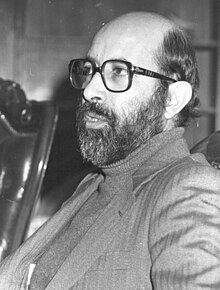Mostafa Tschamran
Mostafa Tschamran Sawei (also Mustafa , English Mostafa Chamran , Persian مصطفی چمران, DMG Moṣṭafā Čamrān Sāveī ; * 1932 in Tehran ; † June 21, 1981 in Abadan ) was an Iranian defense minister and member of the Iranian parliament . He is considered to be one of the most famous martyrs of the early days of the Islamic Republic of Iran.
education
Mostafa Tschamran was born in Tehran in 1932. At the age of 15 he began to be active in Islamic circles and took part in the lectures on the interpretation ( tafsīr ) of the Holy Quran given by Ayatollah Mahmud Taleghani . He learned the subjects of logic and philosophy from Ayatollah Morteza Motahhari . His special learning abilities earned him a scholarship to study in the USA . There he studied a total of 14 years until his master's thesis at Texas A&M University and then his doctoral thesis in the field of electronics and plasma physics at the University of California . He then worked in research in the field of satellite technology and radar radiation. In addition to his native Persian, he had also learned Arabic and English and also spoke French and German .
Revolutionary activities
During his travels around the world he came into close contact with the Islamic groups in Algeria , Egypt , Lebanon and Syria . In Lebanon he learned from the Islamic resistance to the occupation by Israel at the time and took over the management of the Jabal-Amal Technical University in southern Lebanon for eight years. He was on the side of the Amal militia in the fighting against the Israeli occupation forces and against the various parties to the civil war.
Iranian Defense Minister
After the Islamic Revolution in Iran, he returned to his homeland. Because of his experience abroad, he was entrusted with command of a unit of the Pasdaran ; later he was nominated as Minister of Defense. He took part in the resistance against the counterrevolution and was elected in March 1980 by the Tehran population as a representative in the Islamic Advisory Assembly ( Majles ). Ayatollah Ruhollah Khomeini appointed him his representative on the Security Council and his military adviser.
Iran-Iraq war
After Iraq invaded Iran in 1980, he went to Ahwaz Province and organized the resistance with guerrilla tactics , as the regular army had largely disbanded in the course of the revolution. He did not leave the front until his death. On May 21, 1981 Mostafa Tschamran was killed in the city of Abadan - according to official information from the Iranian government - by a fragment of a bomb. According to other sources, he lost his life in an attack ordered by those in charge of the Khomeini regime. He was later buried in the Behescht-e-Zahra cemetery near Tehran. Until his death he had written numerous political writings, most of which were published without declaring himself to be the author.
Web links
- Official site (Persian)
supporting documents
- ^ Bernard Reich, Political Leaders of the Contemporary Middle East and North Africa, p.466
- ^ Daniel Brumberg, Reinventing Khomeini, p.272
- ^ HE Chehabi, Distant Relations, p.208
- ↑ Houchang E. Chehabi, Iranian Politics and Religious Modernism, p.293
- ^ Manouchehr Ganji, Defying the Iranian Revolution, p.109
| personal data | |
|---|---|
| SURNAME | Tschamran, Mostafa |
| ALTERNATIVE NAMES | Tschamran Sawei, Mostafa (full name); Tschamran, Mustafa; Chamran, Mostafa; مصطفی چمران (Persian) |
| BRIEF DESCRIPTION | Iranian Defense Minister and Member of the Iranian Parliament |
| DATE OF BIRTH | 1932 |
| PLACE OF BIRTH | Tehran , Iran |
| DATE OF DEATH | June 21, 1981 |
| Place of death | Abadan , Iran |
